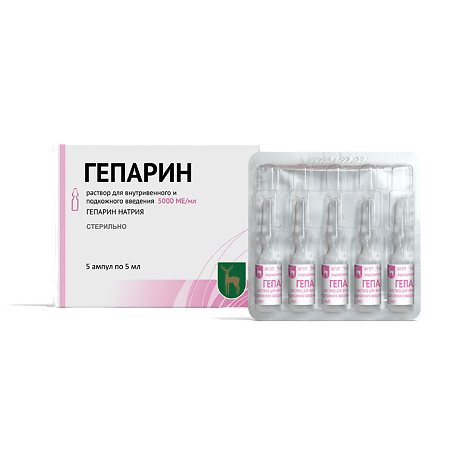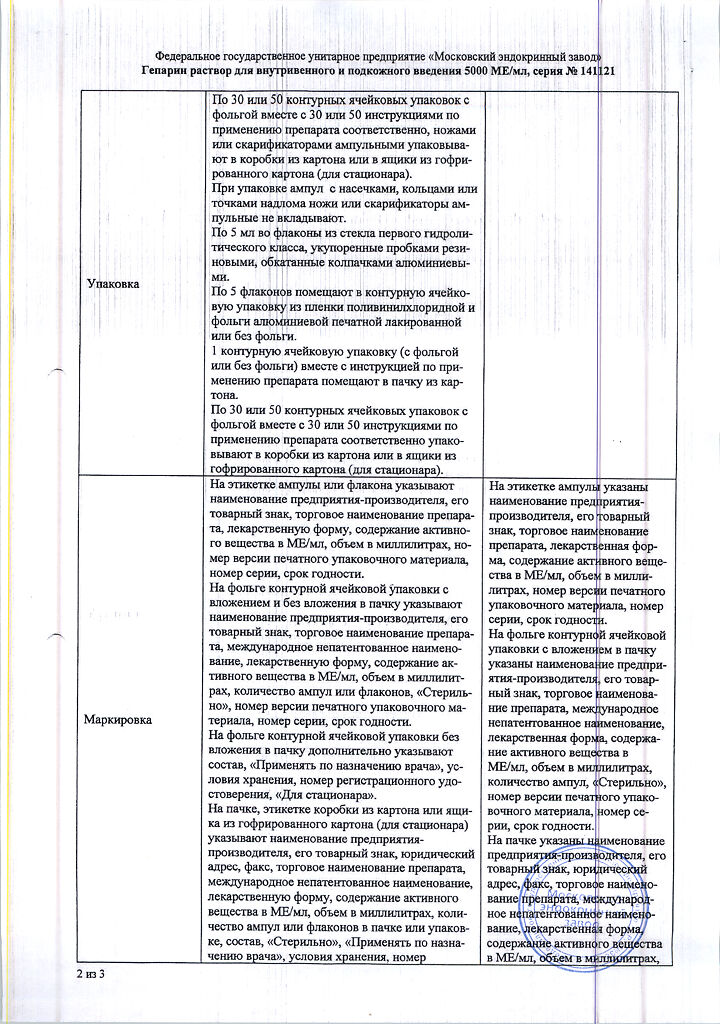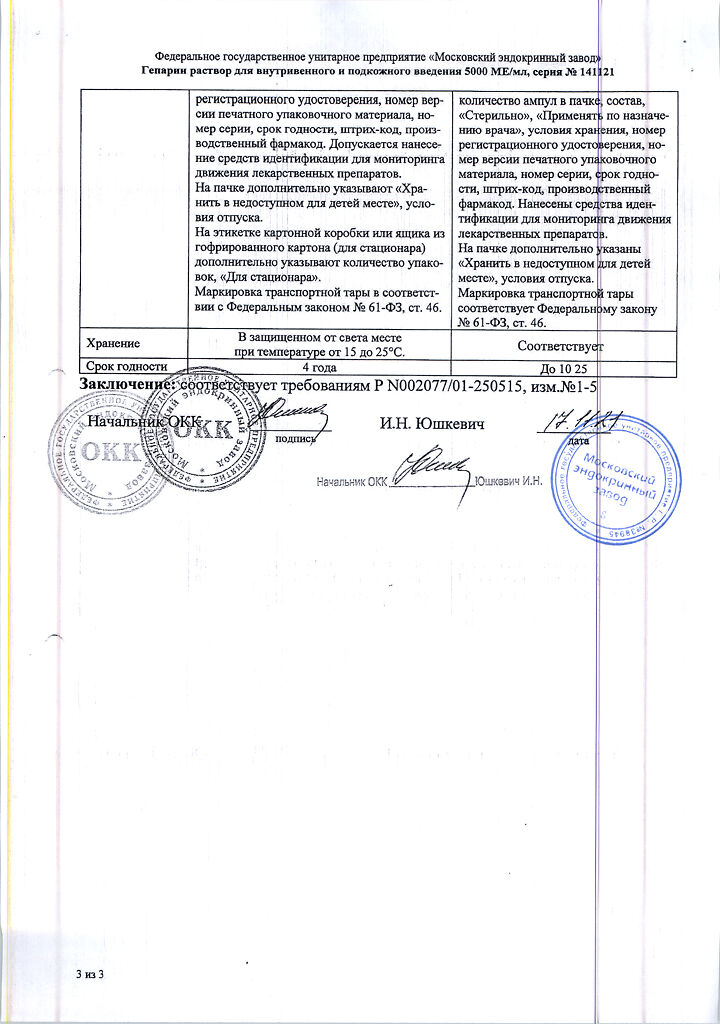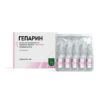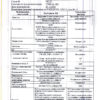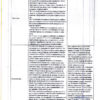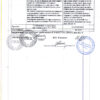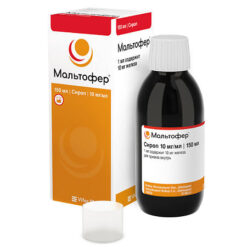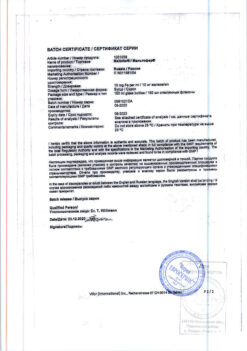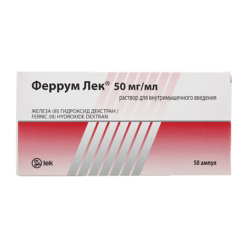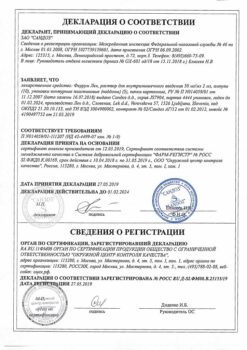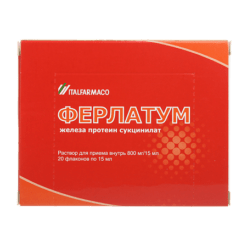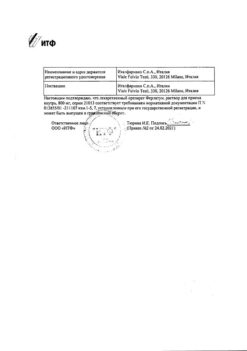No products in the cart.
Heparin,. 5000 me/ml 5 ml 5 pcs.
€46.35 €38.62
Description
Pharmacotherapeutic group: anticoagulant of direct action.
ATH code: B01AB01
Pharmacological properties
Pharmacodynamics
Direct acting anticoagulant. It belongs to the group of medium molecular weight heparins. Inhibits the formation of fibrin. Anticoagulant effect is visible in vitro and in vivo, comes immediately after intravenous administration.
Mechanism of action of sodium heparin is based primarily on binding to antithrombin III – inhibitor of activated blood coagulation factors: IIa (thrombin), IXa, Xa, XIa, XIIa (thrombin and activated factor X is especially important). Sodium heparin increases renal blood flow; increases cerebral vascular resistance, reduces cerebral hyaluronidase activity, activates lipoprotein lipase and has hypolipidemic effect. Reduces surfactant activity in the lungs, suppresses excessive aldosterone synthesis in the adrenal cortex, binds adrenaline, modulates ovarian response to hormonal stimuli, increases parathormone activity. As a result of interaction with enzymes, sodium heparin can increase the activity of brain tyrosine hydroxylase, pepsinogen, DNA polymerase and decrease the activity of myosin ATPase, pyruvate kinase, RNA polymerase, pepsin. The clinical significance of these effects of sodium heparin remains poorly understood.
In patients with coronary heart disease (in combination with acetylsalicylic acid) reduces the risk of acute coronary thrombosis, myocardial infarction and sudden death. Reduces the frequency of recurrent heart attacks and mortality of patients who had a myocardial infarction.
In high doses it is effective for treatment of pulmonary thromboembolism and venous thrombosis; in low doses – for prevention of venous thromboembolism, including after surgical operations.
Anticoagulant effect after a single intravenous injection is achieved in several minutes and lasts up to 4-5 hours. When administered subcutaneously the action begins after 20-30 minutes and lasts for 12 hours or more (depending on the dose). For unfractionated standard heparin the ratio of antiaggregant activity (antifactor Xa) to anticoagulant activity (ACTV) is 1:1.
Deficiency of antithrombin III in plasma or in place of thrombosis may reduce antithrombotic effect of heparin sodium.
Pharmacokinetics
Assimilation
After intravenous administration, maximum concentration (Cmax) is reached almost immediately; after subcutaneous administration, 4-5 hours later.
Distribution
Binding to plasma proteins is up to 95 %; volume of distribution is very small – 0.06 l/kg (does not leave vascular channel due to strong binding to plasma proteins). It does not penetrate through the placental barrier and into breast milk. It is intensively taken up by endothelial cells and cells of mononuclear-macrophage system (reticulo-endothelial system cells – RES) and concentrated in liver and spleen.
Metabolism and elimination
Metabolized in the liver involving N-desulfamidase and platelet heparinase, which is included in the metabolism of sodium heparin at later stages. Participation in the metabolism of platelet factor IV (anti-heparin factor), as well as binding of sodium heparin to the macrophage system explains the rapid biological inactivation and short duration of action. Desulfated molecules under the influence of renal endoglycosidase are converted into low molecular weight fragments.
The half-life of the drug (T½) is 1-6 hours (on average 1.5 hours). Period of semiejection half-life is increased at obesity, renal and hepatic insufficiency, decreased at pulmonary embolism, infectious diseases, malignant tumors.
Excreted by kidneys as inactive metabolites. After administering high doses it can be excreted (up to 50%) unchanged. It is not eliminated by hemodialysis.
Indications
Indications
– prevention and treatment of venous thrombosis (including thrombosis of the superficial and deep veins of the lower extremities; renal vein thrombosis) and pulmonary embolism;
– prevention and treatment of thromboembolic complications associated with atrial fibrillation;
– prevention and treatment of peripheral arterial embolisms (including those associated with mitral heart defects);
– treatment of acute and chronic coagulopathies of consumption (including stage I of DIC syndrome);
– acute coronary syndrome without persistent ST segment elevation on the ECG (unstable angina, myocardial infarction without ST segment elevation on the ECG);
– myocardial infarction with ST segment elevation: with thrombolytic therapy, with primary percutaneous coronary revascularization (balloon angioplasty with or without stenting) and with a high risk of arterial or venous thrombosis and thromboembolism;
– prevention and therapy of microthrombosis and microcirculation disorders, including hemolytic-uremic syndrome, glomerulonephritis (including lupus nephritis) and forced diuresis;
– prevention of blood clotting during blood transfusion, in extracorporeal circulation systems (extracorporeal circulation during cardiac surgery, hemosorption, cytapheresis) and during hemodialysis;
– processing of vascular catheters.
Pharmacological effect
Pharmacological effect
Pharmacotherapeutic group: direct acting anticoagulant.
ATX code: В01АВ01
Pharmacological properties
Pharmacodynamics
Direct acting anticoagulant. Belongs to the group of medium molecular heparins. Slows down fibrin formation. The anticoagulant effect is detected in vitro and in vivo, occurring immediately after intravenous administration.
The mechanism of action of sodium heparin is based primarily on binding to antithrombin III, an inhibitor of activated blood coagulation factors: IIa (thrombin), IXa, Xa, XIa, XIIa (the ability to inhibit thrombin and activated factor X is especially important). Heparin sodium increases renal blood flow; increases cerebral vascular resistance, reduces the activity of cerebral hyaluronidase, activates lipoprotein lipase and has a hypolipidemic effect. Reduces the activity of surfactant in the lungs, suppresses excessive synthesis of aldosterone in the adrenal cortex, binds adrenaline, modulates the ovarian response to hormonal stimuli, and increases the activity of parathyroid hormone. As a result of interaction with enzymes, sodium heparin can increase the activity of brain tyrosine hydroxylase, pepsinogen, DNA polymerase and reduce the activity of myosin ATPase, pyruvate kinase, RNA polymerase, pepsin. The clinical significance of these effects of sodium heparin remains poorly understood.
In patients with coronary heart disease (in combination with acetylsalicylic acid) it reduces the risk of acute coronary artery thrombosis, myocardial infarction and sudden death. Reduces the frequency of recurrent infarctions and mortality in patients who have suffered a myocardial infarction.
In high doses it is effective for pulmonary embolism and venous thrombosis, in small doses it is effective for the prevention of venous thromboembolism, including after surgery.
The anticoagulant effect with a single intravenous administration develops within a few minutes and lasts up to 4-5 hours. When administered subcutaneously, the effect begins within 20-30 minutes and lasts 12 hours or more (depending on the dose). For unfractionated standard heparin, the ratio of antiplatelet activity (antifactor Xa) to anticoagulant activity (APTT) is 1:1.
Deficiency of antithrombin III in plasma or at the site of thrombosis may reduce the antithrombotic effect of sodium heparin.
Pharmacokinetics
Suction
After intravenous administration, the maximum concentration (Cmax) is achieved almost immediately; after subcutaneous administration – after 4-5 hours.
Distribution
Communication with plasma proteins – up to 95%; the volume of distribution is very small – 0.06 l/kg (does not leave the vascular bed due to strong binding to plasma proteins). Does not penetrate the placental barrier and into breast milk. It is intensively captured by endothelial cells and cells of the mononuclear-macrophage system (cells of the reticuloendothelial system – RES), concentrated in the liver and spleen.
Metabolism and elimination
Metabolized in the liver with the participation of N-desulfamidase and platelet heparinase, which is involved in the metabolism of sodium heparin at later stages. Participation in the metabolism of platelet factor IV (antiheparin factor), as well as the binding of sodium heparin to the macrophage system explains the rapid biological inactivation and short duration of action. Desulfated molecules are converted into low molecular weight fragments by kidney endoglycosidase.
The half-life of the drug (T½) is 1-6 hours (average 1.5 hours). The half-life increases with obesity, renal and liver failure, and decreases with pulmonary embolism, infectious diseases, and malignant neoplasms.
Excreted by the kidneys in the form of inactive metabolites. When high doses are administered, excretion (up to 50%) is possible unchanged. Not excreted by hemodialysis.
Special instructions
Special instructions
Heparin resistance
Active ingredient
Active ingredient
Heparin sodium
Composition
Composition
1 ml of solution contains:
Active ingredient:
heparin sodium – 5000 IU
Excipients:
benzyl alcohol – 9.0 mg, sodium chloride – 3.4 mg, hydrochloric acid (hydrochloric acid) or sodium hydroxide – up to pH 5.0-7.5, water for injection – up to 1 ml
Pregnancy
Pregnancy
The use of sodium heparin during pregnancy or breastfeeding is possible only in cases where the expected benefit of therapy for the mother outweighs the potential risk for the fetus or child. You should not use sodium heparin preparations containing benzyl alcohol (see sections “Composition”, “Contraindications”).
Pregnancy
Controlled clinical studies of the use of sodium heparin in pregnant women have not been conducted. Studies in humans and animals have shown that sodium heparin does not cross the placental barrier. To date, there is no data indicating the possibility of fetal malformations due to the use of sodium heparin during pregnancy; There are also no results of animal experiments that would indicate the embryo- or fetotoxic effect of sodium heparin. However, there is evidence of an increased risk of premature birth and spontaneous abortion associated with bleeding. It is necessary to take into account the likelihood of complications when using sodium heparin in pregnant women with concomitant diseases, as well as in pregnant women receiving additional treatment. Daily use of high doses of heparin sodium for more than 3 months may increase the risk of osteoporosis in pregnant women. Therefore, continuous use of high doses of sodium heparin should not exceed 3 months. Epidural anesthesia should not be used in pregnant women undergoing anticoagulant therapy. Anticoagulant therapy is contraindicated if there is a risk of bleeding, for example, with a threatened abortion.
Breastfeeding
Heparin sodium is not excreted in breast milk. Daily use of high doses of heparin sodium for more than 3 months may increase the risk of osteoporosis in breastfeeding women. If it is necessary to use it during the specified periods, it is necessary to compare the expected benefits and risks of using the drug.
Contraindications
Contraindications
hypersensitivity to sodium heparin or other components of the drug;
heparin-induced thrombocytopenia (with or without thrombosis) in history or currently;
bleeding (unless the benefits of sodium heparin outweigh the potential risks);
Heparin sodium in a therapeutic dose should not be prescribed if it is not possible to ensure regular laboratory monitoring of blood clotting;
newborns (up to 28 days of life), especially premature babies (born at 37 weeks of gestation or less) or those with low body weight (2500 grams or less) (the benzyl alcohol contained in the composition can cause toxic and anaphylactoid reactions).
pregnancy and breastfeeding (benzyl alcohol contained in the composition can cause toxic and anaphylactoid reactions).
With caution
– polyvalent allergies (including bronchial asthma);
– pathological conditions associated with an increased risk of bleeding, such as:
– diseases of the cardiovascular system: acute and subacute infective endocarditis, severe uncontrolled arterial hypertension, aortic dissection, cerebral aneurysm;
– diseases of the digestive system: erosive and ulcerative lesions of the gastrointestinal tract (including stress-induced), varicose veins of the esophagus with cirrhosis of the liver and other diseases, long-term use of gastric and small intestinal drainages, ulcerative colitis, hemorrhoids;
– diseases of the hematopoietic organs and lymphatic system: leukemia, hemophilia, thrombocytopenia, hemorrhagic diathesis;
– diseases of the central nervous system: hemorrhagic stroke, traumatic brain injury;
– malignant neoplasms;
– congenital deficiency of antithrombin III and replacement therapy with antithrombin III drugs (to reduce the risk of bleeding, it is necessary to use lower doses of the drug);
– treatment with fibrinolytics, oral anticoagulants, agents that inhibit platelet aggregation, such as acetylsalicylic acid, ticlopidine, clopidogrel, blockers of glycoprotein IIb/IIIa platelet receptors;
– treatment with drugs that increase the concentration of potassium in the blood serum, as well as the presence of a risk of developing hyperkalemia (for example, diabetes mellitus, impaired renal function);
– other physiological and pathological conditions: menstruation period, threat of miscarriage, early postpartum period (first 2-4 hours after birth), severe liver disease with impaired protein-synthetic function, chronic renal failure, recent surgery on the eyes, brain or spinal cord, recent lumbar puncture, spinal or epidural anesthesia, proliferative diabetic retinopathy, vasculitis;
– children under 3 years of age (benzyl alcohol included in the composition can cause toxic and anaphylactoid reactions);
– old age (over 60 years old, especially women).
The use of sodium heparin is possible in cases where the expected benefit of therapy outweighs the potential risk.
Side Effects
Side Effects
WHO classification of adverse reactions by frequency of development
Very often
1 per 10 appointments
≥ 10%
Often
1 in 100 appointments
≥ 1% but < 10%
Uncommon
1 in 1,000 appointments
≥ 0.1% but < 1%
Rarely
1 in 10,000 appointments
≥ 0.01% but < 0.1%
Very rarely
less than 1 in 10,000 prescriptions
<0.01%
Frequency unknown
cannot be estimated from available data
Organ system class
(MedDRA)
Frequency of occurrence
Adverse reactions
Blood and lymphatic system disorders
Very often
Bleeding1
Often
Thrombocytopenia2
Immune system disorders
Uncommon
Allergic reactions: skin flushing, urticaria, conjunctivitis, rhinitis, asthma, cyanosis, tachypnea, feeling of constriction, fever, chills, angioedema, itching and feeling of heat in the soles, bronchospasm
Very rarely
Severe allergic reactions: anaphylactic shock
Endocrine system disorders
Uncommon
Hypoaldosteronism3
Metabolic and nutritional disorders
Uncommon
Increased lipoprotein lipase concentration with the development of recurrent hyperlipidemia during heparin withdrawal3
Nervous system disorders
Frequency unknown
Dizziness, headache
Vascular disorders
Often
Hematoma
Gastrointestinal disorders
Frequency unknown
Nausea, vomiting, loss of appetite, diarrhea
Disorders of the liver and biliary tract
Uncommon
Increased activity of “liver” transaminases (ALT, AST)3
Skin and subcutaneous tissue disorders
Often
Erythematous nodules, infiltrated, sometimes eczema-like plaques at the site of subcutaneous injections4
Uncommon
Alopecia3, skin itching, skin rash (including erythematous and maculopapular)
Rarely
Local irritation3, skin necrosis3
Musculoskeletal and connective tissue disorders
Uncommon
Osteoporosis3, spontaneous bone fractures3, joint pain3, soft tissue calcification3
Disorders of the genital organs and breast
Uncommon
Priapism3
General and administration site disorders
Very often
Insufficient effectiveness (based on APTT determination)5
Often
Hematoma, irritation, pain, hyperemia, ulceration at the injection site
Laboratory and instrumental data
Uncommon
Hyperkalemia, increased concentrations of free fatty acids, increased activity of “liver” transaminases (ALT, AST), increased thyroxine concentrations, false increases in glucose concentrations, errors in the results of the bromsulfalein test, eosinophilia, increased blood pressure
Notes:
Typical bleeding: from the gastrointestinal tract and urinary tract; at the site of drug administration; in areas subject to pressure; from surgical wounds; hemorrhages in various organs (including the adrenal glands, corpus luteum, retroperitoneal space).
At the beginning of heparin treatment, transient thrombocytopenia may sometimes be observed with platelet counts ranging from 80 × 109/L to 150 × 109/L. Usually this situation does not lead to the development of complications and heparin treatment can be continued. In rare cases, severe thrombocytopenia (white blood clot syndrome), sometimes fatal, may occur. This complication should be assumed if the platelet count decreases below 80 × 109/L or by more than 50% of the initial level; heparin administration in such cases is immediately stopped. Patients with severe thrombocytopenia may develop consumptive coagulopathy (fibrinogen depletion). Against the background of heparin-induced thrombocytopenia: skin necrosis, arterial thrombosis, accompanied by the development of gangrene, myocardial infarction, stroke.
If severe thrombocytopenia develops (a decrease in the platelet count by 2 times the initial number or below 100 × 109/L), it is necessary to stop using heparin.
Heparin-induced thrombocytopenia (HIT) and heparin-induced thrombocytopenia with thrombosis (HITT) may occur for several weeks after discontinuation of heparin treatment. If thrombocytopenia or thrombosis is detected in a patient after discontinuation of heparin, the possibility of HIT or HITT should be assessed.
With long-term use (for several months).
3-21 days after starting heparin treatment.
Observed in conditions associated with antithrombin III deficiency or other concomitant diseases (see section “Special instructions”, subsection “Heparin resistance”) during treatment with any drugs of unfractionated heparin.
Interaction
Interaction
Pharmaceutical interactions
Heparin sodium solution is diluted only with physiological solution (0.9% sodium chloride solution). Heparin sodium solution is incompatible with the following substances: alteplase, amikacin sulfate, amiodarone, ampicillin sodium, benzylpenicillin sodium, ciprofloxacin, cytarabine, dacarbazine, danorubicin, diazepam, dobutamine, doxorubicin hydrochloride, droperidol, erythromycin, gentamicin sulfate, haloperidol lactate, hyaluronidase, hydrocortisone sodium succinate, dextrose (glucose), fat emulsions, idarubicin, kanamycin sulfate, methicillin sodium, netilmicin sulfate, opioids, oxytetracycline hydrochloride, polymyxin B sulfate, promazine hydrochloride, promethazine hydrochloride, streptomycin sulfate, sulfafurazole diethanolamine, tetracycline hydrochloride, tobramycin sulfate, cephalothin sodium, cephaloridine, vancomycin hydrochloride, vinblastine sulfate, labetalol hydrochloride, nicardipine hydrochloride.
Pharmacokinetic interaction
Sodium heparin displaces phenytoin, quinidine, propranolol and benzodiazepine derivatives from the sites of their binding to plasma proteins, which can lead to increased pharmacological effects of these drugs. Sodium heparin binds and is inactivated by protamine sulfate, alkaline polypeptides, and tricyclic antidepressants.
Pharmacodynamic interaction
The anticoagulant effect of sodium heparin is enhanced by simultaneous use with other drugs that affect hemostasis, including antiplatelet drugs (acetylsalicylic acid, clopidogrel, prasugrel, ticlopidine, dipyridamole, epoprostenol/prostaglandins), indirect anticoagulants (warfarin, phenindione, acenocoumarol), thrombolytic drugs (alteplase, streptokinase, urokinase), non-steroidal anti-inflammatory drugs (phenylbutazone, ibuprofen, indomethacin, diclofenac, etc.), glucocorticoids and dextran, which increases the risk of bleeding. In addition, the anticoagulant effect of sodium heparin may be enhanced when combined with hydroxychloroquine, sulfinpyrazone, probenecid, ethacrynic acid, cytostatics, cefamandole, cefotetan, valproic acid, propylthiouracil. The anticoagulant effect of sodium heparin is reduced when used simultaneously with adrenocorticotropic hormone (ACTH), antihistamines, ascorbic acid, ergot alkaloids, nicotine, nitroglycerin, cardiac glycosides, thyroxine, tetracycline and quinine.
Heparin sodium may reduce the pharmacological effects of ACTH, glucocorticoids and insulin.
Before any surgical interventions using sodium heparin, oral anticoagulants and antiplatelet agents should be discontinued at least 5 days in advance, because they may increase bleeding during surgery or in the postoperative period.
Overdose
Overdose
Symptoms: bleeding, most often from the skin, mucous membranes, wounds, gastrointestinal tract, genitourinary tract (for example, nosebleeds, hematuria, melena, hematomas, pinpoint hemorrhages). Decreased blood pressure, decreased hematocrit, or other symptoms indicating occult bleeding.
Treatment: for moderate, non-life-threatening bleeding caused by an overdose of sodium heparin, it is enough to stop using it. In case of severe, life-threatening bleeding, excess sodium heparin is neutralized with protamine sulfate (1 mg of protamine sulfate per 100 IU of heparin). It must be borne in mind that sodium heparin is eliminated quickly, and if protamine sulfate is prescribed 30 minutes after the administration of sodium heparin, only half the required dose should be administered. The maximum dose of protamine sulfate should be no more than 50 mg. As a bolus injection of protamine sulfate, it is given slowly over about 10 minutes. When using protamine sulfate, severe anaphylactic reactions with a fatal outcome were observed, and therefore the drug should be administered only in a department equipped to provide emergency medical care for anaphylactic shock. Neutralization of sodium heparin is assessed by thrombin time and APTT.
Hemodialysis is ineffective against sodium heparin.
Storage conditions
Storage conditions
In a place protected from light at a temperature of 15 to 25 ° C.
Keep out of the reach of children.
Shelf life
Shelf life
4 years. Do not use after the expiration date stated on the package.
Manufacturer
Manufacturer
Moscow Endocrine Plant, Russia
Additional information
| Shelf life | 4 years. Do not use after the expiration date stated on the package. |
|---|---|
| Conditions of storage | In the dark place at temperatures from 15 to 25 ° C. Keep out of reach of children. |
| Manufacturer | Moscow Endocrine Plant, Russia |
| Medication form | solution |
| Brand | Moscow Endocrine Plant |
Related products
Buy Heparin,. 5000 me/ml 5 ml 5 pcs. with delivery to USA, UK, Europe and over 120 other countries.

